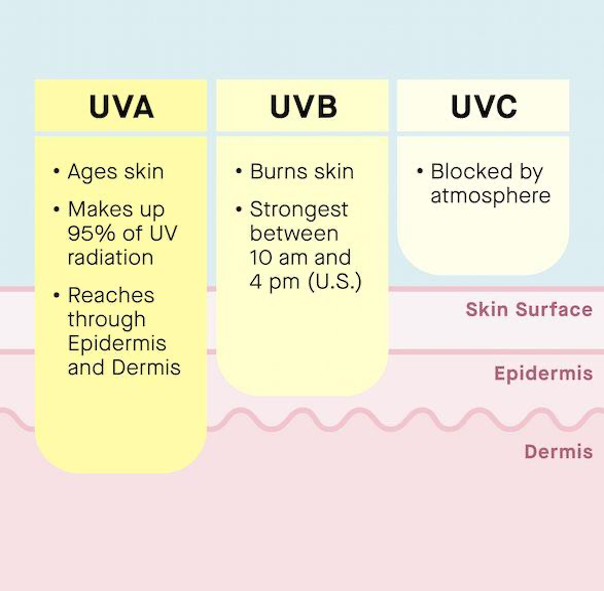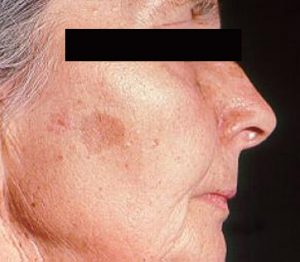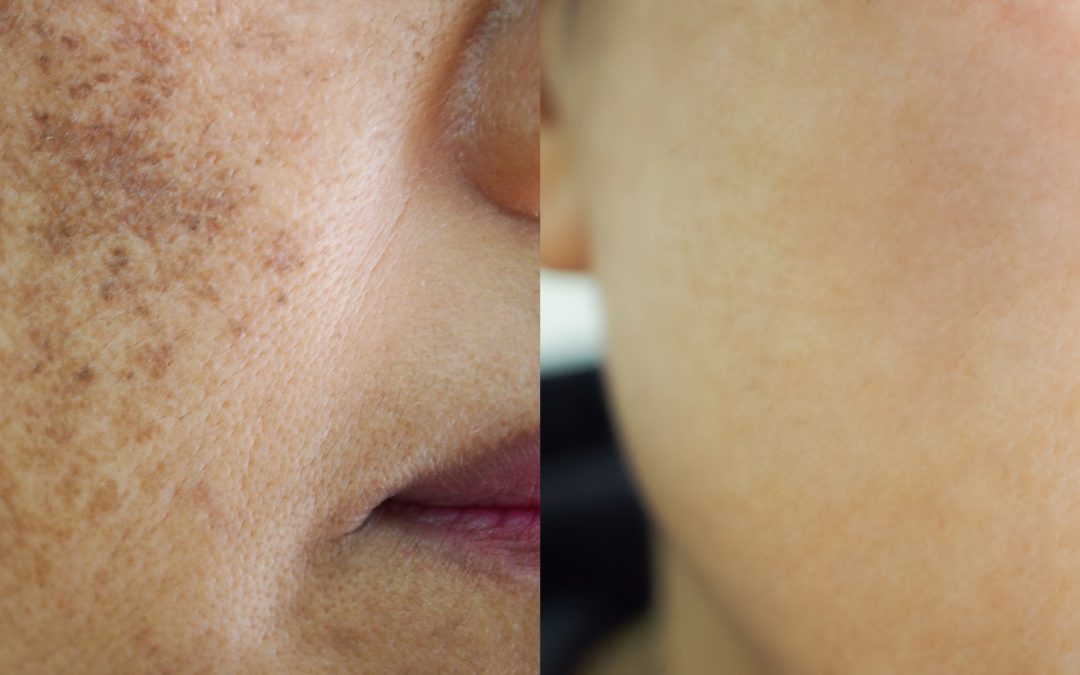- SUNSPOTS / SUN DAMAGED SKIN
Did you know that UV radiation is one of the factors which damages our skin most, making it age prematurely? Different types of UV radiation and the effect on the skin?  The most common form of UV radiation is sunlight, which produces three main types of UV rays: UVA, UVB, UVC UVA rays have the longest wavelengths, followed by UVB, and UVC rays which have the shortest wavelengths. While UVA and UVB rays are transmitted through the atmosphere, all UVC and some UVB rays are absorbed by the Earth’s ozone layer. So, most of the UV rays you come in contact with are UVA with a small amount of UVB. Like all forms of light on the EM spectrum, UV radiation is classified by wavelength. Wavelength describes the distance between the peaks in a series of waves. UVB rays have a short wavelength that reaches the outer layer of your skin (the epidermis) UVA rays have a longer wavelength that can penetrate the middle layer of your skin (the dermis) What is UVC Radiation? UVC radiation is the highest energy portion of the UV radiation spectrum. UVC radiation from the sun does not reach the earth’s surface because it is blocked by the ozone layer in the atmosphere. Thus, the only way that humans can be exposed to UVC radiation is from an artificial source like a lamp or laser. What are the risks of exposure to UVC radiation? Once exposed to the sun the skin has the ability to protect itself from the harmful light, therefore, will start producing more melanin(skin color) in some areas more than others resulting in uneven skin tone, fine lines, and wrinkles.
The most common form of UV radiation is sunlight, which produces three main types of UV rays: UVA, UVB, UVC UVA rays have the longest wavelengths, followed by UVB, and UVC rays which have the shortest wavelengths. While UVA and UVB rays are transmitted through the atmosphere, all UVC and some UVB rays are absorbed by the Earth’s ozone layer. So, most of the UV rays you come in contact with are UVA with a small amount of UVB. Like all forms of light on the EM spectrum, UV radiation is classified by wavelength. Wavelength describes the distance between the peaks in a series of waves. UVB rays have a short wavelength that reaches the outer layer of your skin (the epidermis) UVA rays have a longer wavelength that can penetrate the middle layer of your skin (the dermis) What is UVC Radiation? UVC radiation is the highest energy portion of the UV radiation spectrum. UVC radiation from the sun does not reach the earth’s surface because it is blocked by the ozone layer in the atmosphere. Thus, the only way that humans can be exposed to UVC radiation is from an artificial source like a lamp or laser. What are the risks of exposure to UVC radiation? Once exposed to the sun the skin has the ability to protect itself from the harmful light, therefore, will start producing more melanin(skin color) in some areas more than others resulting in uneven skin tone, fine lines, and wrinkles.  THE face of an elderly truck driver shows how the sun’s powerful and dangerous UV rays can slowly destroy the skin. Published by the New England Journal of Medicine, the picture shows a 69-year-old man who has spent half of his life on the road. The left side of his face is significantly damaged from the UV radiation through the years , causing the skin to develop much deeper wrinkles (the result of underneath completely destroyed collagen net).
THE face of an elderly truck driver shows how the sun’s powerful and dangerous UV rays can slowly destroy the skin. Published by the New England Journal of Medicine, the picture shows a 69-year-old man who has spent half of his life on the road. The left side of his face is significantly damaged from the UV radiation through the years , causing the skin to develop much deeper wrinkles (the result of underneath completely destroyed collagen net).  The picture shows typical sun-damaged skin. The patches on the skin are not very dark and are distributed kind of evenly all over the face. We are noticing uneven skin tone. That pigmentation is very superficial and can be very easily removed with either Skin Peels or 1-3 Laser Sessions. The pigmentation forms because the skin responds to protect from the UV radiation is a normal body process. But as we age, the skin’s ability to distribute the additional pigment evenly is slowing down and therefore starts forming darkening in some areas not everywhere as we would have at a young age ( suntan ).
The picture shows typical sun-damaged skin. The patches on the skin are not very dark and are distributed kind of evenly all over the face. We are noticing uneven skin tone. That pigmentation is very superficial and can be very easily removed with either Skin Peels or 1-3 Laser Sessions. The pigmentation forms because the skin responds to protect from the UV radiation is a normal body process. But as we age, the skin’s ability to distribute the additional pigment evenly is slowing down and therefore starts forming darkening in some areas not everywhere as we would have at a young age ( suntan ).
- AGE SPOTS
 A condition marked by small brown patches on the skin, typically in elderly people. Similar to the sun damage, the pigmentation is epidermal, very superficial, and can be very easily removed with either Skin Peels or 1-3 Laser Sessions.
A condition marked by small brown patches on the skin, typically in elderly people. Similar to the sun damage, the pigmentation is epidermal, very superficial, and can be very easily removed with either Skin Peels or 1-3 Laser Sessions.
- MELASMA/CHLOASMA
 Also called ‘chloasma’ and ‘pregnancy mask’, is a common skin condition of adults in which light to dark brown or greyish patches of pigmentation develop mainly on facial skin. The name comes from melas, the Greek word for black. It is more common in women, especially pregnant women, and people with darker skin-types who live in sunny climates. however, it can also affect men (10% of patients) and any race. Melasma usually becomes more noticeable in the summer and improves during the winter months. It is not an infection therefore it is not contagious, and it is not due to an allergy. It is not cancerous and will not develop into skin cancer. The exact cause is not known, but several factors can contribute. these include pregnancy, hormonal drugs such as the oral contraceptive pill, and medical conditions that affect hormone levels, sunshine and the use of sunbeds can make the tendency to melasma worse. Very few lasers can treat melasma, due to the possibility of the condition to worsen. Melasma doesn’t like light and heat, and can often get worst because of you spending too much time coking. COSMELAN PEEL is described by many professionals- doctors, aestheticians, skincare experts, the world’s leading professional pigmentation removal method. The treatment is suitable for all forms of hyperpigmentation from melasma, post-inflammatory hyperpigmentation, solar lentigo to ephelides (freckles) and can be used on all skin phototype’s (Fitzpatrick skin types)- from very light skin to very dark skins- READ more for COSMELAN PEEL HERE
Also called ‘chloasma’ and ‘pregnancy mask’, is a common skin condition of adults in which light to dark brown or greyish patches of pigmentation develop mainly on facial skin. The name comes from melas, the Greek word for black. It is more common in women, especially pregnant women, and people with darker skin-types who live in sunny climates. however, it can also affect men (10% of patients) and any race. Melasma usually becomes more noticeable in the summer and improves during the winter months. It is not an infection therefore it is not contagious, and it is not due to an allergy. It is not cancerous and will not develop into skin cancer. The exact cause is not known, but several factors can contribute. these include pregnancy, hormonal drugs such as the oral contraceptive pill, and medical conditions that affect hormone levels, sunshine and the use of sunbeds can make the tendency to melasma worse. Very few lasers can treat melasma, due to the possibility of the condition to worsen. Melasma doesn’t like light and heat, and can often get worst because of you spending too much time coking. COSMELAN PEEL is described by many professionals- doctors, aestheticians, skincare experts, the world’s leading professional pigmentation removal method. The treatment is suitable for all forms of hyperpigmentation from melasma, post-inflammatory hyperpigmentation, solar lentigo to ephelides (freckles) and can be used on all skin phototype’s (Fitzpatrick skin types)- from very light skin to very dark skins- READ more for COSMELAN PEEL HERE  Watch the FULL Video of Cosmelan treatment below:
Watch the FULL Video of Cosmelan treatment below:
